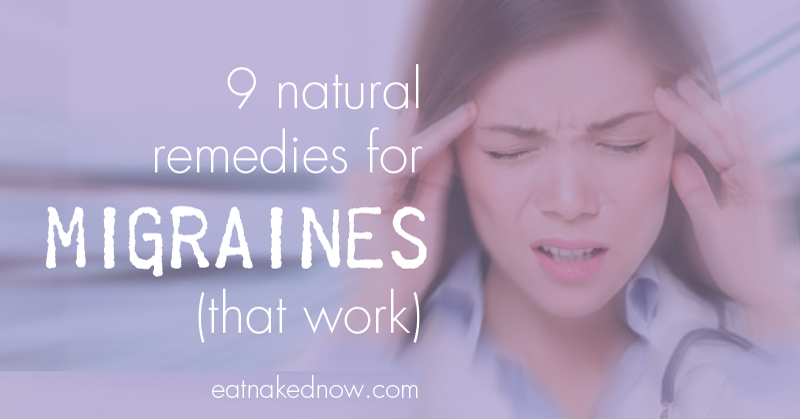I woke up at 3am, rolled over, and sighed deeply as I recognized the early warning signs: tension in my back that was creeping up one side of my neck and wrapping its way around my head, gripping onto one eyeball with its steadfast, steely hold. I was still early enough into the process that the nausea hadn’t hit yet. But I knew it was on its way. It was only a matter of time.
If you suffer from migraines, your symptoms may look different but you know of what I speak: that sinking feeling when the signs stack up and you think to yourself with dread, “Oh God, here it comes.”
In my old life, I used to rush for the medicine cabinet – pop a few ibuprophen, or later, my beloved Excedrin Migraine (I should have taken out stock in the stuff I used it so often). Even after I’d dramatically reduced the number of migraines through dietary and lifestyle change, Mama Migraine sometimes had other things in mind for me. Often my only recourse was a full-fledged painkiller. I tried natural remedies, but nothing seemed to work, and some of them just exacerbated the situation.
And then I got pregnant. This both increased the number of migraines I had (hello, hormones) and reduced my options for painkillers. Natural remedies became my only recourse. Here are my nine go-to strategies at the first sign of a migraine.
Important note: Migraines are no joke, and so I don’t mess around when using natural solutions. I don’t just use one or two of these strategies; I throw everything I have at it. Most of the time, I’m able to move through it quickly.
1) Anti-inflame, naturally.
Move over ibuprophen, enter natural healing foods that up-regulate my body’s ability to anti-inflame. Some of my favorites are turmeric in my tea and an extra dose (or two) of my favorite cod liver oil. I also try to avoid those foods that are inflaming as a general rule. See here for more information on strategies for how to reduce inflammation naturally.
(Did you know that over-the-counter NSAIDS – non-steroidal anti-inflammatories – actually inhibit the body’s natural ability to anti-inflame? Short-term gain for long-term pain. Not worth it. And not necessary when you can have the same effect naturally.)
2) Hydrate
Did you know that migraines are a sign of significant dehydration? This is an easy one to knock off the list. Just drink more water. But make sure it’s good, filtered water (check out some of these home water filtration systems ), and that your body can actually absorb it. Add a pinch of unrefined sea salt to add minerals for better absorption.
3) Caffeine
You know why Excedrin migraine works so well? It’s just a pain-killer (acetaminophen), anti-inflammatory (aspirin) and caffeine. If you respond well to this combination, then let’s do it the natural way. You’re supporting your body’s own ability to anti-inflame as we discussed in point #1 above, and we’ll look at some natural pain killers in the points below. Add a cup of coffee and you’ve got the caffeine covered.
Now, I’m not arguing that coffee is good for you, and you might be one of those folks for whom caffeine just makes the migraine worse. In that case, obviously skip it.
4) Magnesium oil spray on tight muscles
 Magnesium is the mineral responsible for allowing muscles to relax (as opposed to calcium, which is required for muscular contraction). Is it any coincidence that migraines are also often associated with a magnesium deficiency? My favorite way to supplement with magnesium is topically through a spray (like this one by Ancient Minerals) because it bypasses the digestive tract and your body will absorb only what it needs. Ideally, you’d be using this preventatively on a regular basis, but I will spray it on the tight muscles in my neck, shoulders and upper back when migraines hit.
Magnesium is the mineral responsible for allowing muscles to relax (as opposed to calcium, which is required for muscular contraction). Is it any coincidence that migraines are also often associated with a magnesium deficiency? My favorite way to supplement with magnesium is topically through a spray (like this one by Ancient Minerals) because it bypasses the digestive tract and your body will absorb only what it needs. Ideally, you’d be using this preventatively on a regular basis, but I will spray it on the tight muscles in my neck, shoulders and upper back when migraines hit.
5) Stretch and roll out tight muscles
Hand-in-hand with the magnesium spray is some deep tissue massage to work out the kinks. If you don’t have a massage therapist on call (everyone needs one of those!) you can use a combination of old tennis balls in a sock and a foam roller to get out the worse knots. I learned a trick recently that works wonders on the muscles that are particularly aggravated by a migraine:
– Lie on your back with your knees up and your feet on the floor.
– Place the sock with tennis balls between your shoulder blades along one side of your spine, running parallel to your spine.
– Rest the back of your neck on the foam roller, which will be placed perpendicular to your spine.
– Now extend the arm that’s on the same side as the tennis balls (e.g., if the tennis balls are on the right side of your spine, extend your right arm). With the arm extended, bring it across your body slowly and then back again. This mimicks the massage therapist digging into that muscle – instead of the tennis balls moving, you’re moving your muscle over the ball. It’s hard to describe, but feels heavenly.
– For an extra bonus, roll your head from side to side as you do this to get into those tight muscles in your neck. Bliss.
– Don’t forget to switch up the sides and do it on the other side as well!
6) Essential oils
I’ve recently begun experimenting with essential oils for all sorts of therapeutic benefit and have been incredibly impressed. They’re for so much more than just making things smell nice! When I have a migraine, I dab a little Peppermint oil on my temples and third eye (great for pain relief), and I rub either Nerve Repair (supports circulation and nerves), Gallbladder (supports many headache meridian points), or Parasympathetic (supports relaxation) into my neck and shoulders to help ease the tension. Amazing! All of these oils have powerful pain-blocking, anti-inflammatory and anti-spasmodic properties. Who needs Advil?
Interesting side note: I often feel like there’s wind blowing through my brain when a migraine has finally lifted. The peppermint oil inspires that same feeling. It’s wild and wonderful!
Another great oil to try is a special blend of marjoram, lavender, peppermint, basil, chamomile and helichrysum called (appropriately) Migraine Relief. These oils are powerful anti-inflammatories and anti-spasmodics, and the peppermint oil has pain-blocking properties. Add a couple of drops to a bath, or apply directly to temples, back of neck, forehead, and shoulders.

7) Homeopathics
Homeopathy is a system of medicine that uses highly diluted substances designed to trigger the body’s natural healing mechanisms. It is based on the principle that like cures like: a substance that causes the symptoms of a disease in healthy people will cure similar symptoms in sick people. Remedies are typically given in tablet form and are very gentle. There’s lots of debate over whether homeopathics are placebo or truly effective, but I’ve had great results with them.
What homeopathic remedy works best for your migraine will really depend on what type of migraine you have and how the symptoms manifest for you specifically. I highly recommend working with a healing professional trained in homeopathy to determine what remedy is best for you.
Here are some common homeopathic remedies and the kinds of headache they help:
– Gelsenium is good for those migraines (like mine!) that feel like a tension headache that starts from your neck and shoulders, and extends up and around your head. I’ll often use this in combination with Arnica or Chamomilla, both of which are very effective for pain relief.
– Ignatia is another helpful remedy, particularly for those migraines that are worse when you lean over. Ignatia helps with headaches that are relieved by lying on the painful side (if you’ve had one of these, you know exactly what I’m talking about here).
– Nat Mur is particularly effective for those severe migraines that feel as though someone is operating a jack-hammer inside your head. It’s also good for migraines that develop above the eyes and involve vision problems.
– Nux Vomica can be helpful with the nausea associated with migraines, as well as those headaches triggered by overwork or overindulgence (read: hangover).
– Sepia is another great remedy for migraines that come with nausea.
– Ferrum Phos is helpful for migraines triggered by excess sun.
8) Sleep
What is the body really asking for when we have a migraine? Sleep. A dark room. Quiet. Lack of sleep is a key trigger for migraines and so, in the body’s deepest wisdom, the cure is in the sickness itself. If at all possible, go back to bed. Give your body what it’s asking for. Sometimes (I’d say always…) Mama Migraine knows best.
9) Cold cloths and hot packs
This last combination just feels really good: a cold cloth on the forehead and a hot pack on the back of the neck. In part it has to do with opening and closing the capillaries. In part, it just feels good.
What are your strategies for handling a migraine naturally?
For more related reading:
21 Home Remedies for Migraines and Headaches




thanks for this information! I just bought the magnesium spray. I’m excited to try everything you suggested here…..my migraine medication makes me feel groggy & sleepy. Would love to find a better solution.
Magnesium spray can make a huge difference! Keen to hear how it works for you.
This is great information! The topic of migraines comes up so frequently and it can be such a mystery to find remedies. Your list has introduced me to some fresh ideas. Thank you!!
I like your article, thank you for sharing.
amazing ideas! I have been taking fossil shell flour for about 6 weeks now. My migraines are usually pre menstrual, and I didn’t get a migraine this time around!
Thanks for sharing this, I know exactly what you’re describing and I’m excited to try these remedies when the time comes upon me…
i have suffered from migraines since I was about 5 years old. I go through good spells where I only have 1 or 2 a month but my normal is 1 a week if not more. They have never been able to figure out why I suffer from them and medications have never really worked plus I’m sick of them. So THANK YOU for finally providing some new suggestions that I am willing to try. Most of the other more common things have not worked for me. I’d also like to add that soaking in comfortably warm but not hot tub with an ice pack on my neck will sometimes help with my migraines depending on the type(currently helping with one that’s trying to rip my left eye ball out).
I have exactly Same problem as yours. I have migraine ever since I could remember. I am 30now
I am so sorry, Katie. I got them 61 years ago, when I was 10 and my period started. One doc told me that if they started with my period, odds were good they would stop when my period stopped. Nope. Still there. Like you, I will try these new (to me) suggestions because pain meds only strengthen my tinnitus these days and do not really help at all. My husband of 40 years would like them to go away almost as much as I. Good luck!
Thank you for all this information. I just started using Arnica for my daily migraines and have plans to try all your other suggestions as well. You are helping innumerable people by sharing your information and experiences. You give me hope so Blessed Be.
My mom is 88 this year and still suffers from migraines. I am 65 and still have them. A hot water bottle behind my neck helps so much and a wafer from the doctor I place under my tongue in a tablet form that melts within a minute my migraine lasts about 1 hour. Drink water always to hydrate you every day, drink herbal tea no caffine
Fresh feverfew tea helps me a lot. Has to be leaf tea, fresh or freshly dried. Tablets off the shelf don’t work at all. I grow feverfew and dry it for the winter but this year I’m growing some indoors under lights. It works well lifting the pressure off but it is the worst tasting stuff I’ve ever had. Once you feel how well it works, you won’t care about the taste! It’s a very hardy perennial and looks good in the garden.
Ice cold cloths on the head help a lot too.